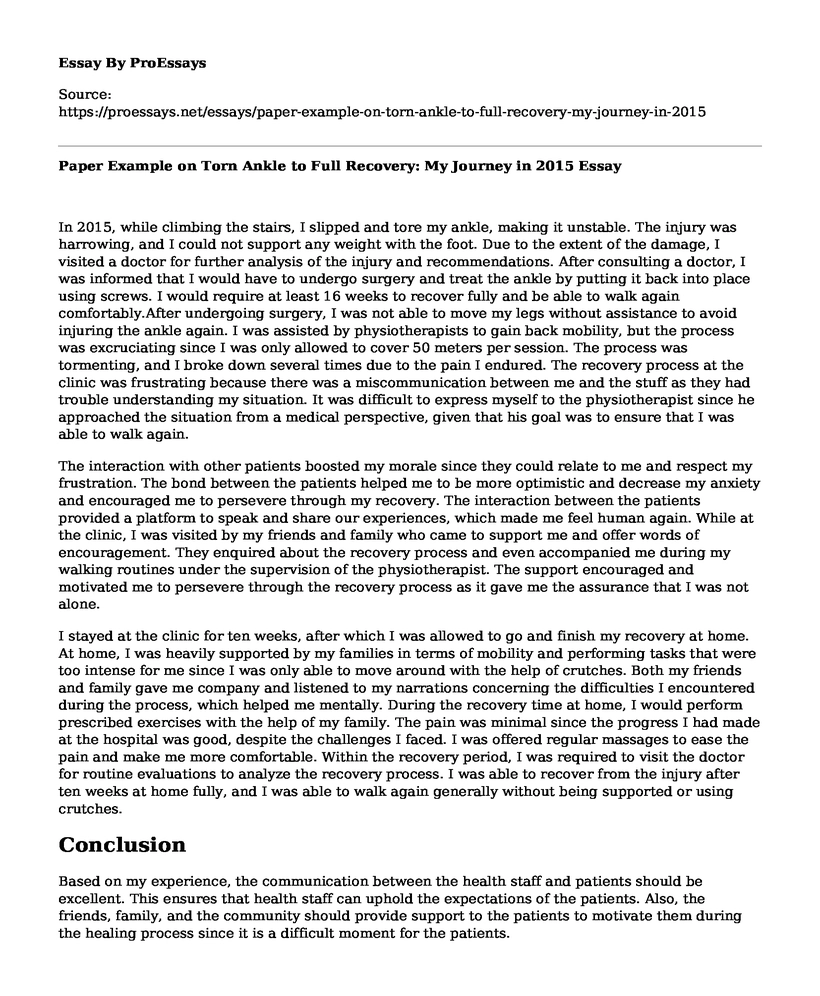In 2015, while climbing the stairs, I slipped and tore my ankle, making it unstable. The injury was harrowing, and I could not support any weight with the foot. Due to the extent of the damage, I visited a doctor for further analysis of the injury and recommendations. After consulting a doctor, I was informed that I would have to undergo surgery and treat the ankle by putting it back into place using screws. I would require at least 16 weeks to recover fully and be able to walk again comfortably.After undergoing surgery, I was not able to move my legs without assistance to avoid injuring the ankle again. I was assisted by physiotherapists to gain back mobility, but the process was excruciating since I was only allowed to cover 50 meters per session. The process was tormenting, and I broke down several times due to the pain I endured. The recovery process at the clinic was frustrating because there was a miscommunication between me and the stuff as they had trouble understanding my situation. It was difficult to express myself to the physiotherapist since he approached the situation from a medical perspective, given that his goal was to ensure that I was able to walk again.
The interaction with other patients boosted my morale since they could relate to me and respect my frustration. The bond between the patients helped me to be more optimistic and decrease my anxiety and encouraged me to persevere through my recovery. The interaction between the patients provided a platform to speak and share our experiences, which made me feel human again. While at the clinic, I was visited by my friends and family who came to support me and offer words of encouragement. They enquired about the recovery process and even accompanied me during my walking routines under the supervision of the physiotherapist. The support encouraged and motivated me to persevere through the recovery process as it gave me the assurance that I was not alone.
I stayed at the clinic for ten weeks, after which I was allowed to go and finish my recovery at home. At home, I was heavily supported by my families in terms of mobility and performing tasks that were too intense for me since I was only able to move around with the help of crutches. Both my friends and family gave me company and listened to my narrations concerning the difficulties I encountered during the process, which helped me mentally. During the recovery time at home, I would perform prescribed exercises with the help of my family. The pain was minimal since the progress I had made at the hospital was good, despite the challenges I faced. I was offered regular massages to ease the pain and make me more comfortable. Within the recovery period, I was required to visit the doctor for routine evaluations to analyze the recovery process. I was able to recover from the injury after ten weeks at home fully, and I was able to walk again generally without being supported or using crutches.
Conclusion
Based on my experience, the communication between the health staff and patients should be excellent. This ensures that health staff can uphold the expectations of the patients. Also, the friends, family, and the community should provide support to the patients to motivate them during the healing process since it is a difficult moment for the patients.
Cite this page
Paper Example on Torn Ankle to Full Recovery: My Journey in 2015. (2023, May 08). Retrieved from https://proessays.net/essays/paper-example-on-torn-ankle-to-full-recovery-my-journey-in-2015
If you are the original author of this essay and no longer wish to have it published on the ProEssays website, please click below to request its removal:
- Essay Sample on Maxime Fitness Company
- Essay Sample on Role of Epidemiology in Public Health
- Paper Example on Asthma: Evolving Pharmacotherapy and Pathophysiology
- NAON: Professional Development for Orthopaedic Nurses - Essay Sample
- Coronavirus COVID-19: Global Pandemic, Rising Cases Worldwide - Essay Sample
- Paper Example on Somatization Disorder: Distress, Physical Symptoms, and Diagnosis
- Report Example on Circadian Dysrhythmia







